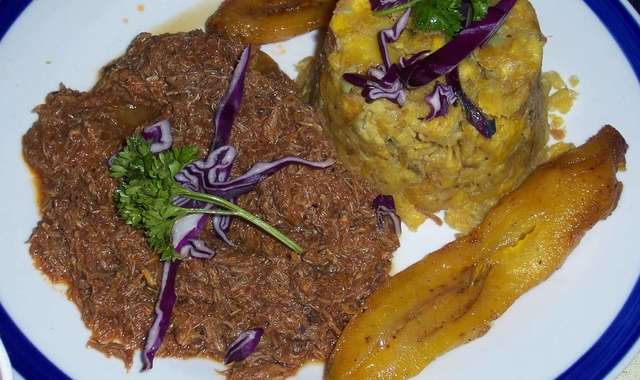Dateline: Kitchens Nationwide
By Sofia Perez
[Published by Epicurious.com, June 12, 2006]
National Puerto Rican Day was marked yesterday across the United States—since 1995, Puerto Ricans have been celebrating their culture on the second Sunday in June, while in New York City, the festivities date back to 1958. As usual, it was a day of movement, filled with parades and dancing, which is a very good thing, because after you’ve consumed a typical Puerto Rican meal, you will need to get up and do the merengue. Look all you want, but you will not find any of those cute “heart healthy” logos on an authentic Puerto Rican menu. This is food for serious eaters: robust, satisfying, and full of flavor.
In Puerto Rico, traditional cuisine is known as cocina criolla (Creole cooking), which also tells you something about the island’s history, shaped by indigenous residents, Spanish colonizers, and African slaves brought over to work on sugar plantations. The food that results is a blend of both Old and New World influences, with the piquant notes of the Caribbean thrown in for good measure. Vegetarian visitors do not have it easy (even dishes that seem like options—rice and beans, say—are flavored with pork or other animal fat), but meat lovers will consider the place paradise. Lechón asado (whole suckling pig, rubbed with spices and roasted outdoors on a spit) is a Christmastime favorite, while mondongo (a hearty beef tripe stew) will fill your belly year-round. Because of its geography, the island also boasts great fish dishes, such as camarones al ajillo (garlic shrimp) and salt cod salad.
On the average menu, you should assume “fried” is implied, even when it’s not spelled out. Whether you order bacalaítos (deep-fried codfish fritters), tostones (double-fried smashed green plantains), or mofongo (fried plantains mixed with garlic and olive oil, and often shaped around a meat or fish filling), most ingredients will have taken at least one dip in hot oil. A good way to cut through the meal’s heaviness is through the liberal use of pique, a spicy condiment of hot chiles, vinegar, and spices; the best Creole restaurants produce their own homemade versions, which you’ll usually find on the table in a repurposed glass bottle.
Perhaps out of a need to counteract the food’s savory wallop, sweets are also big in Puerto Rico. To sate your sugar cravings, order arroz con leche (rice pudding) or the coconut custard known as tembleque—though a simple batido (shake) of milk blended with ripe tropical fruit is a healthier alternative. If you’re watching your waistline, there are an increasing number of Nuevo Latino eateries that have sprung up in the past few years (particularly in San Juan), offering lighter, Asian-inspired fusion cuisine. Some are quite good.
But if it’s a real taste of the island that you’re after, head to a place like La Casita Blanca (351 Calle Tapia, 787-726-5501), which is located in the capital’s Santurce neighborhood. The warm, unpretentious service and faithful re-creations of the classics will make you feel right at home. Why bother counting calories anyway? You’ll be burning them soon enough with a night of dancing.



